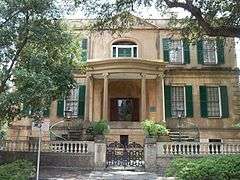Owens-Thomas House
|
Owens-Thomas House | |
|
Owen-Thomas House in 2011 | |
| Location | 124 Abercorn Street, Savannah, Georgia |
|---|---|
| Coordinates | 32°04′39″N 81°05′22″W / 32.07738°N 81.08940°WCoordinates: 32°04′39″N 81°05′22″W / 32.07738°N 81.08940°W |
| Built | 1816 |
| Architect | William Jay |
| Architectural style | Early Republic, Other |
| Part of | Savannah Historic District (Savannah, Georgia) (#66000277) |
| NRHP Reference # | 76000611 |
| Significant dates | |
| Added to NRHP | May 11, 1976[1] |
| Designated NHL | May 11, 1976[2] |
The Owens-Thomas House is a historic home in Savannah, Georgia that is operated as a historic house museum by Telfair Museums. It is located at 124 Abercorn Street, on the northeast corner of Oglethorpe Square.[3] The Owens-Thomas House was designated a National Historic Landmark in 1976, as one of the nation's finest examples of English Regency architecture.[2][4]
Architectural style and house history
This most important and architecturally significant house was begun in 1816 and completed in 1819. Designed by the English architect William Jay of Bath, the house plans were drawn while Jay was still in England. He sent architectural elevations to local workers before his arrival in Savannah sometime after foundations were laid. According to Jay's letters, the house was to be aesthetically compatible to Bath, England. This is evident in the Bath stone of the house's construction as well as its sophisticated architectural detail. It was a gentrifying physical ornament to the newly successful Southern port. The Richardson House, as it was originally known after its first owner and builder, is North America's preeminent example of period English Regency architecture. The mansion was purchased in 1830 by local attorney and politician George Welshman Owens for $10,000. The family maintained it for several decades until Owens' granddaughter, Margaret Thomas, bequeathed the house to the Telfair Academy of Arts and Sciences (established in 1885) as the South's oldest art museum, in 1951. The house is notable for its early cast iron side veranda with elaborate acanthus scroll supports on which the Marquis de Lafayette addressed the citizens of Savannah on his visit in 1825. William Jay was architect to other Savannah landmarks such as the Scarborough house, the Telfair House as mentioned above, and an attribution to the Gordon-Low House.
Museum
The Owens-Thomas House collection contains furnishings and decorative arts from the English Regency period; containing effects of the Owens family, most pieces dating from the years 1790 to 1840.[5] Collections include English Georgian and American Federal period furniture, early Savannah textiles, silver, Chinese Export porcelain, and 18th- and 19th-century art. The house-servant's quarters feature slave artifacts of the period. Courtyard features a small parterre garden.
See also
- List of National Historic Landmarks in Georgia (U.S. state)
- National Register of Historic Places listings in Chatham County, Georgia
Footnotes
- ↑ National Park Service (2007-01-23). "National Register Information System". National Register of Historic Places. National Park Service.
- 1 2 "Owens-Thomas House". National Historic Landmark summary listing. National Park Service. Retrieved 2007-10-19.
- ↑ "Owens-Thomas House, Telfair Museum of Art Website".
- ↑ Carolyn Pitts (January 29, 1976). "National Register of Historic Places Inventory-Nomination: Owens-Thomas House / Richardson-Owens-Thomas House" (pdf). National Park Service. and Accompanying 4 photos, exterior, from 1973 and undated. (2.15 MB)
- ↑ http://www.telfair.org/buildings/ot_house_collec.asp Collection
External links
- www.telfair.org Official web site
- Owens-Thomas House - Telfair Museum of Art
- Historic American Buildings Survey (HABS) No. GA-14-9, "Richardson-Maxwell-Owen-Thomas House, 124 Abercorn Street, Savannah, Chatham County, GA", 20 photos, 9 measured drawings, 3 data pages, supplemental material
-
 Media related to Owens-Thomas House at Wikimedia Commons
Media related to Owens-Thomas House at Wikimedia Commons - Owens-Thomas House historical marker
